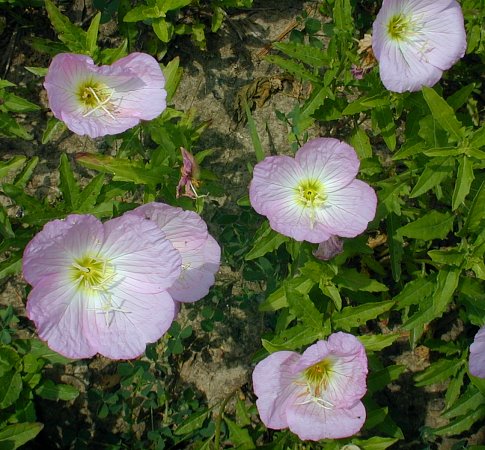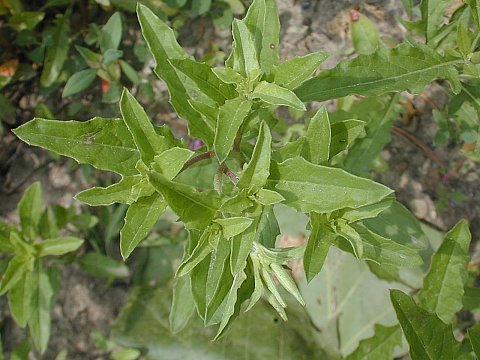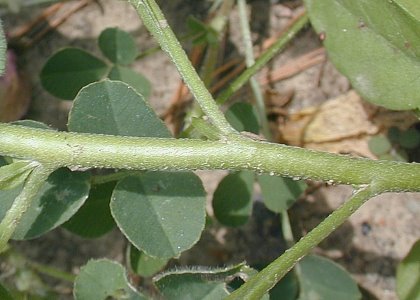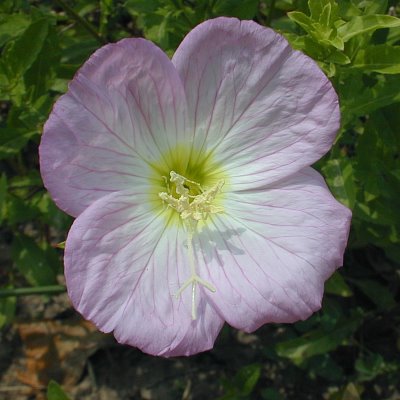Description: This perennial plant is is usually ½-2' tall. The light green stems are terete, covered with appressed pubescence, and either erect or sprawling. The central stem is usually little branched, except near the apex of the plant, where the flowers occur. The alternate leaves are up to 2-3" long and ¾" across. They are lanceolate, elliptic, or oblanceolate in shape, while their margins are smooth (entire), dentate, or shallowly pinnatifid. Some leaves may have paired basal lobes. The leaves are either sessile against their stems or they have petioles up to 1" in length. Both the upper and lower leaf surfaces are light to medium green and either glabrous or sparsely appressed-pubescent.

About 1-3 flowers develop from the axils of the upper leaves. The appressed-pubescent flower buds are rather long and spindle-shaped. The showy flowers open up during the daytime, and they are 2-3½" across. Each flower has 4 broad petals, 8 stamens with white or yellow anthers, and a long white stigma that is 4-cleft at its tip, resembling a white cross. These flowers are usually pinkish white; they have fine pink lines that radiate outward from their throats across the rather wrinkled petals. The throats of these flowers are usually yellow. The blooming period occurs from late spring to mid-summer, lasting about a month, although individual flowers are short-lived. The flowers are replaced by elongated 4-angled capsules that contain numerous seeds. The root system is highly rhizomatous, forming sizable colonies at some sites.

Cultivation:
The
preference is full sun and dry conditions. This plant often grows on
poor, rocky soil, but it can tolerate other kinds of soil as well. This
plant can spread aggressively at dry, sunny locations, and it becomes
rather ragged in appearance after the blooming period is over.
Range & Habitat:
Showy Evening Primrose is widely scattered across Illinois, where
it has been reported most often from the Chicago area, central
Illinois, and SW Illinois (see Distribution
Map).
It is native to the Great Plains and other areas that lie west of
Illinois. Habitats include upland areas of degraded prairies, glades,
old homesteads and abandoned fields, areas along railroads
and roadsides, and dry waste areas. In Illinois, Showy Evening
Primrose occurs
primarily in disturbed areas. Many local populations are undoubtedly
cultivated plants that have managed to escape for one reason or
another. This species has been naturalized in Illinois for a long time.

Faunal Associations: Small bees collect pollen from the flowers, but they are unlikely to pollinate them. The size and length of the stamens and style suggest that hummingbirds, large butterflies, or day-flying Sphinx moths are more likely to pollinate the flowers while seeking nectar, although this is somewhat speculative. Some insects feed destructively on the foliage and other parts of Showy Evening Primrose and other Oenothera spp. (Evening Primrose species). These insect species include the flea beetles Altica texana and Altica polita, the aphids Anoecia oenotherae and Aphis oestlundi, the weevil Acanthoscelidius acephalus, and the larvae of several moths. Among these moths, there are several Mompha spp. that feed on the seed capsules or bore through the stems, the flower-eating Schinia florida (Primrose Moth), and the foliage-eating Proserpinus juanita (Green-Banded Day Sphinx). The foliage is occasionally browsed by various mammalian herbivores, including rabbits, groundhogs, deer, and livestock.

Photographic
Location:
A flower garden in Urbana, Illinois.
Comments:
Considering the size of Showy Evening Primrose as a plant, the flowers
seem
impossibly large. They are also very bright and showy. For this reason,
this species is often cultivated in flower gardens in areas far outside
its normal range in the Great Plains and southwestern states. It can be
distinguished from other Oenothera
spp. by its large pinkish white flowers. Other species in
this genus typically have yellow flowers.